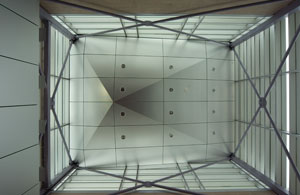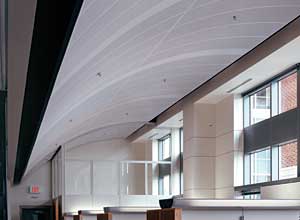Perforated Metal and Wood Ceilings: Sustainability, Acoustics, and Aesthetics
Minimum IAQ Performance and Ventilation Effectiveness (LEED Prerequisite EQ-1 and Credit EQ-2): Indoor air quality (IAQ) depends, in part, on having air diffusers and ventilation devices that distribute air efficiently and effectively. CAD/CAM fabrication allows metal and wood panels to be fabricated to incorporate diffusers and ventilation devices into an integrated ceiling that offers both high performance and a tailored appearance.
|
Another IAQ approach is to minimize the potential growth of mold, mildew, and other microorganisms within a building. The new breed of perforated panels has smooth, dense surfaces that minimize opportunities for growth of microorganisms and can be easily cleaned. Conventional mineral fiber ceiling panels often contain cellulose that can provide nourishment for microorganisms. And both mineral fiber panels and glass fiber insulation can retain moisture necessary for microorganism growth. Perforated panels, however, do not have either of these drawbacks since they use a new type of non-woven acoustical fabric that does not support microorganisms.
Construction IAQ Management Plan (LEED Credit EQ-3): Perforated panels contribute only minimally to indoor air contamination during construction because they are fabricated off-site, reduce on-site cutting and finishing, typically do not contain frangible materials that release fibers or dust, and have smooth, dense surfaces that are easy to clean.
|
Daylight & Views (LEED Credit EQ-8): One of the most useful strategies for bringing daylight into a space is to locate windows as high as possible along exterior walls. This can be at odds with the desire to drop ceilings so that ducts and other utilities can be run above the ceilings. The new generation of ceilings accommodates both needs through the innovative use of curved ceiling panels to create light scoops or accommodate clearstory glazing and high window walls. Equally important are reflective panel finishes that can help make the most of natural lighting.











